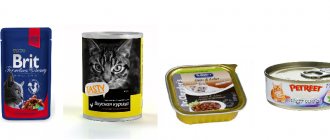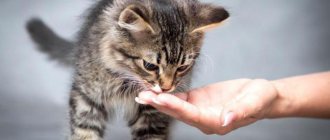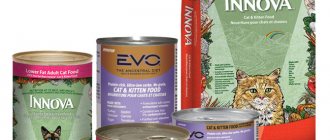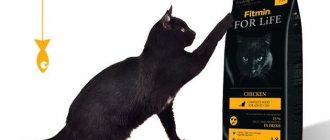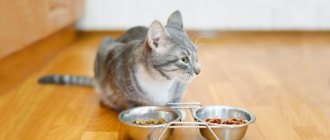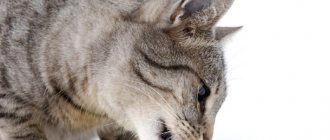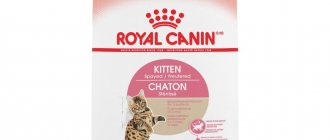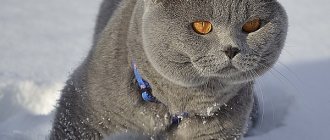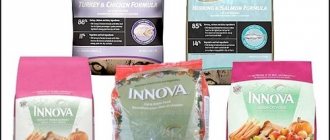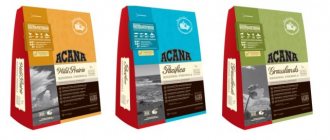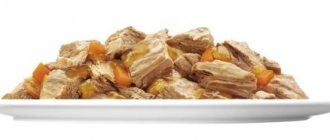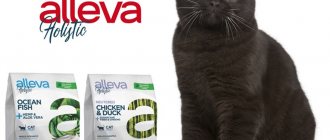Variety of options
Pet stores offer a wide selection of diets - dry and wet, designed for different breeds and ages. However, given that not all manufacturers write explanations in Russian, the choice often becomes difficult.
Food can be homemade - prepared by the owner, or industrial - food for animals produced in factories.
They may differ:
- composition;
- consistency;
- application features.
The industrial category is divided into the following subtypes:
- dry;
- wet;
- canned.
They require separate consideration.
How to feed
Feeding a cat with dry food should only be done if the cat has constant access to drinking water. In conditions of constant feeding on dry food, the cat must consume a large amount of liquid per day.
If she drinks little, it is better to give up the dry diet.
The norm is to feed food from the same manufacturer so that the pet does not have to get used to different foods. If for some reason the crispy pads do not impress the cat or cause an allergy, you can try products from another manufacturer or switch the animal to a different type of food.
There are two ways to transfer a cat from one diet to another (natural food is preferable).
The first way to switch a cat to another food is radical and requires getting rid of all types of ready-made treats. If a pack of aromatic crisps remains in the cupboard, it will not be possible to move the cat, since he will smell and ask for his usual food.
The second method suggests a gradual reduction in portions of dry food and an increase in the proportion of natural food. It will be easier to switch your cat to another food using this method. At first the cat may refuse to eat in both cases, but after a few days hunger will overcome pride and the cat will begin to eat.
Dry
This food is produced using complete dehydration of natural ingredients. The meat is supplemented with vegetables, cereals and legumes.
The composition depends on the product class and purpose.
This form of nutrition is used for the animal’s daily diet or when traveling, for example, to an exhibition. This is convenient: granules do not belong to the category of perishable goods.
They are also liked by cats, who can crunch them with pleasure, which helps cleanse their teeth of tartar and plaque.
Advantages and disadvantages
Veterinarians often recommend dry food for
Super-premium and holistic class cats, because they have a lot of positive qualities:
- Feeding your cat dry food is very convenient, as it does not take much time. It is enough to pour crunchy balls into a bowl a couple of times a day, the cat will do the rest himself;
- pets treat dry food with a special aspiration and are ready to jump around the kitchen at the mere sight of a package of food in the hands of the owner;
- high-quality dry cat food has a perfectly balanced composition, so the cat does not need additional vitamin complexes;
- dry food is stored for a long time, so you don’t have to worry that food opened today will become unusable tomorrow;
- the texture of this food has a good effect on your pet’s teeth, protecting them from plaque and the formation of tartar.
Dry cat food is good enough, but not ideal, because it has its drawbacks, like other types of food:
- if the cat consumes little liquid, then you should not feed it only dry food;
- high-quality dry food is quite expensive, and feeding a cat cheap “dry” food can result in terrible diseases of the gastrointestinal tract;
- It is better to select food in accordance with the age and health of the pet. If you feed your kitten dry food for adult cats, problems may arise;
- After feeding dry food for a long time, it will be difficult to switch the cat to another type of food.
It is normal for an owner to be unsure whether to feed their cat dry food. Regardless of what food the cat owner chooses, it is important to pay sufficient attention to feeding the pet. So, you need to feed your cat dry food in accordance with certain rules.
Wet
These include:
- meat;
- fish;
- bouillon.
Depending on the class, the protein component in it can be from 50% to 90%. The product is packaged in packs and undergoes heat treatment, as a result of which useful substances remain in the jelly.
Such food has an important positive aspect - a variety of tastes, thanks to which even the most capricious cat can eat what he likes.
They have a short shelf life: usually it is better not to leave them open for more than 12 hours. In addition, soft pieces are not able to remove tartar, so we are not talking about its prevention in this case either. As for the cost, good wet food is expensive: not every owner can afford to include it in the pet’s daily diet.
Canned food - production and difference from dry food
Wet food is produced similarly to dry food, but instead of drying, the technology includes preservation of the semi-finished product.
The moisture content of canned cat foods - purees, stews, jelly, mousses and others - reaches eighty percent. It is important to know it in order to correctly determine the composition of other components, most importantly - proteins and fats.
For example, at 80% humidity, the can says 5% fiber content. By calculating this share from the remaining 20% of dry products, you can see that in fact its content is 25%. The same recalculation can determine the content of fats, proteins, and macroelements.
It’s a bad sign if the canned food label contains the words “flavors of.” This only means that the composition contains artificial flavors.
In developed countries, it is prohibited to write “all” on the label, which means that the product consists of 100% one component - meat, fish, etc. This is technologically impossible and is a trick of the manufacturer, a deception.
Classification
Cat food differs not only in composition, but also in quality. To determine it, the Fredalina scale was created, which takes into account the amount of natural components, as well as harmful and beneficial substances.
Calculation starts from 100 points. If the food contains by-products, then 10 points are deducted from it for each.
For example, if:
- the food contains vegetable pomace, which means minus 10 points;
- if in addition to the marc there is bone meal – minus 20 points;
- the composition is approved by a veterinarian, then for food it is +5 points;
- it contains vegetables and probiotics - additional +3 points.
Class varieties of feed
Many owners, having heard about the class variety of feed. They wonder what this means. What are the main differences between feeds? The main differences between classes of feed are their price and composition. There are three classes of cat food: economy, medium and premium. Let's take a closer look at each of them.
- Economy class cat food . These are the cheapest cat foods. They are used only to reduce the pet's hunger. Economy class food has very low nutritional value, so consuming it every day can cause irreparable harm to your pet. These foods contain soy protein and by-products (such as animal entrails, skin and bones, and some even contain bird feathers). Various chemical additives and flavorings give these foods different colors and tastes. Dry food even contains dyes, as evidenced by its different shapes and colors. Daily consumption of economy class food will lead to poor condition of the animal’s skin and coat, and in some cases, its frequent consumption may threaten the animal with the acquisition of urolithiasis. Economy class food includes brands such as Whiskas, Sheba, Darling, Friskies and Kitekat.
- Medium class cat food. They contain much less chemical components and flavorings than economy-class feed, which increases their nutritional value. These foods also contain by-products, but unlike economy-class foods, these ingredients in middle-class foods are of higher quality and safer for your pet’s health. In addition, middle-class foods are divided among themselves not only by taste, but also by their purpose. They are common for removing hair from a cat’s body, as well as for preventing the pet from developing urolithiasis. However, it should be remembered that medicated feeds are not suitable for daily consumption. Middle-class food includes such brands of food as Perfect Fit, Royal Canin, Karma Organic, Cat Chow, Acana and Pro PAC Ultimates.
- The top shelf of cat food is occupied by Premium class food . These are highly nutritious and expensive pet foods. They do not contain dyes or flavoring additives. Plus, they are soy and grain free. These feeds have high nutritional properties, which means they require less daily use. Premium food comes in many varieties. They are medicated, prepared specifically for small kittens, cats with long hair, as well as sterilized or neutered cats. Chicken Soup brand . These foods are hypoallergenic and consist of natural animal and poultry meat. In addition, the percentage of cereals in Chicken Soup is quite low and amounts to 34%.
Premium food also includes food from the Hill's, Pro Plan, Royal Canin and Nutro Choise brands.
If you want to switch your pet from one food to another. This should be done gradually. Within two weeks, you need to add some new food to your cat's daily routine. In addition, to avoid digestive problems, it is recommended to add probiotics to cat food. Selecting the most appropriate probiotics specifically for your pet is the responsibility of your treating veterinarian, whom you can contact.
Cat food rating
In our rating, cat food is divided into 4 classes:
- Holistics. This is the best nutrition with a high percentage of natural products.
- Super premium. They are healthy and contain 80% natural products.
- Premium This food contains a high content of plant proteins and by-products.
- Economy These foods are chosen with care, ideally they should be purchased from trusted suppliers, as they can harm the animal.
Holistic class
Holistic class is a new generation premium food. It appeared on the feed market relatively recently, but has already managed to win the trust of professionals, breeders and lovers of expensive breeds.
Distinctive features of holistic class feeds:
- High content of natural meat (up to 75%)
- Country of origin: USA, UK, Denmark, Germany.
- Safety. The components included in the composition are confirmed by several organizations - first the FDA (American Food and Drug Association), and then AAFCO (American Association of Food and Drug Administration).
As you can see, the line between super-premium and holistic food is quite blurred. Therefore, we invite you to familiarize yourself with the percentage that holistic class food must meet.
Ratio table for holistic-class dry food
The most famous brands of holistic food are: “Acana”, “Innova”, “Orijen”.
We invite you to familiarize yourself with the ratings of food of various classes:
- Orijen
- Innova Evo
- Eukanuba
- Acana
- 1st Choice
- N&D Natural and Delicious
- Pro Plan
- ProBalance
- Royal Canin
- Hills Science Diet (Prescription Diet)
- Felix
- Sheba
- Friskies/Whiskas
As you can see, holistic and super-premium food top the ratings.
